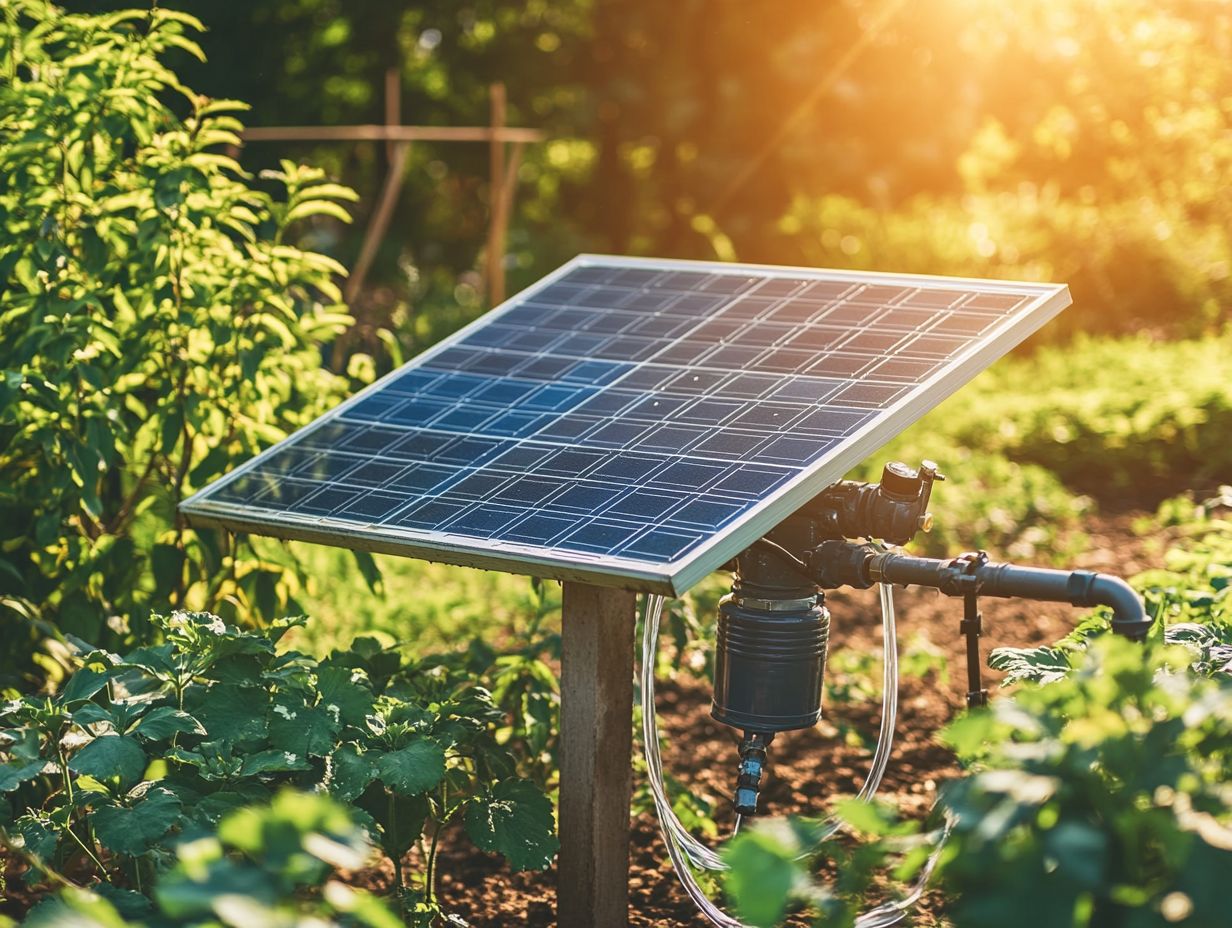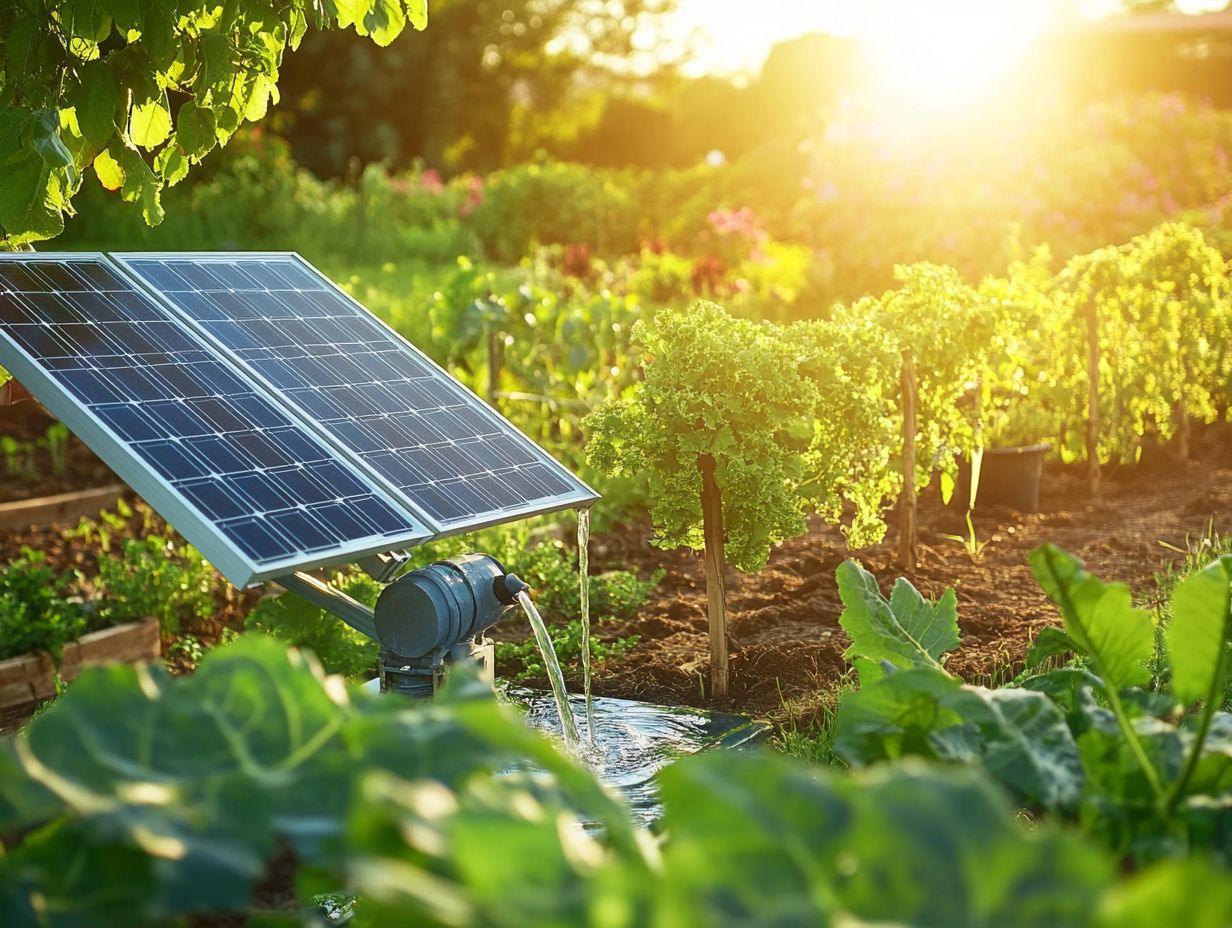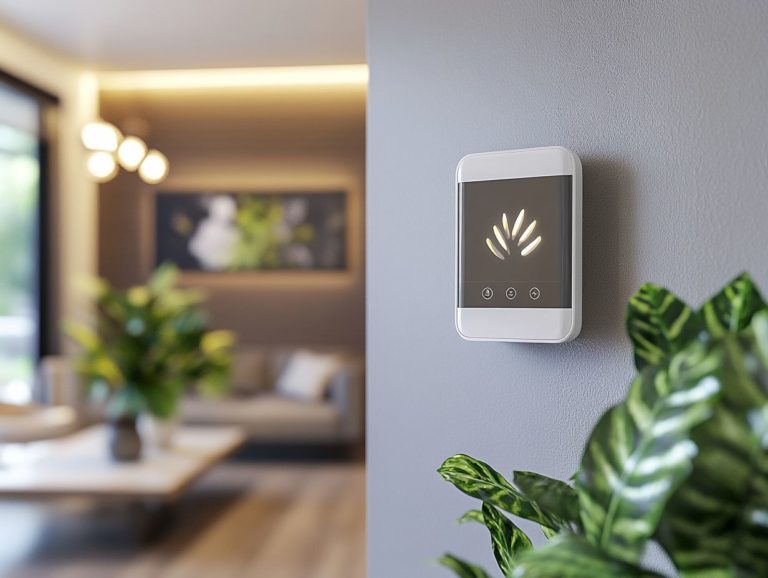How to Build a Solar-Powered Water Pump
Are you in search of a sustainable and cost-effective solution to manage your water needs? A solar-powered water pump could be just what you need.
This article delves into the world of these innovative pumps, showcasing their environmental benefits and the potential for significant cost savings, especially for those with agricultural land. Discover various types, required materials, and a step-by-step guide to creating your solar pump system.
You will also find essential maintenance tips to ensure your setup operates seamlessly with low maintenance requirements. Dive into this exciting exploration and unlock the potential of harnessing the sun’s power for your water pumping needs, whether for residential water requirements or commercial uses!
Contents
- Key Takeaways:
- Benefits of Using a Solar-Powered Water Pump
- Types of Solar-Powered Water Pumps
- Materials and Tools Needed
- Step-by-Step Guide to Building a Solar-Powered Water Pump
- Maintenance, Troubleshooting, and Solar Energy Investment
- Frequently Asked Questions
- 1. How do I start building a Solar Water Pump?
- 2. How does a solar-powered water pump work?
- 3. Do I need any special skills or knowledge to build a solar-powered water pump?
- 4. How much space do I need to install a solar-powered water pump?
- 5. Can I use a solar-powered water pump for all my water needs?
- 6. Are there any maintenance requirements for a solar-powered water pump?
Key Takeaways:

- Solar-powered water pumps have numerous benefits, including environmental sustainability and cost savings.
- There are two types of solar-powered water pumps: submersible and surface, which have different uses and features.
- To build a solar-powered water pump, you will need a list of necessary supplies and follow a step-by-step guide, with maintenance being crucial for efficient operation.
What is a Solar-Powered Water Pump?
A solar-powered water pump presents an innovative and sustainable solution that harnesses solar energy to address various water management needs for home, livestock, or agricultural irrigation. This technology utilizes solar panels to convert sunlight into electricity, allowing the pump to deliver water efficiently without relying on traditional energy sources.
The fusion of a solar panel array and a submersible pump is easy to maintain and provides a cost-effective option for homeowners, farmers, and businesses, particularly in developing regions where power outages are common.
Typically, these systems comprise solar panels, a charge controller, batteries for energy storage, and the pump itself. If you’re interested in learning more, check out this guide on how to make your own solar water pump. All components are customizable to meet your specific requirements based on flow rate (the amount of water the pump can move) and piping resistance (the effort the pump needs to push water through pipes).
By choosing the right pump, you can maximize efficiency and ensure optimal water delivery even under fluctuating demand conditions. The installation process is simple: simply mount the solar panels in a sunlit area and connect them to the pump system. To further enhance your solar setup, consider exploring how to build a battery bank for solar energy. You’ll find that this approach generally requires less infrastructure than conventional pumps.
Solar-powered pumps are not just for agriculture; they are also versatile, serving applications like fisheries, landscape irrigation, and even supplying water to remote communities. They prove to be a reliable and eco-friendly choice for tackling a variety of water supply challenges.
Benefits of Using a Solar-Powered Water Pump
Using a solar-powered water pump gives you fantastic advantages, making it an appealing option for both residential and commercial applications, particularly in agricultural environments.
These systems harness the power of renewable energy, drastically diminishing your dependence on fossil fuels and fostering energy independence, all while championing environmental sustainability.
The economic benefits of solar energy solutions further bolster their allure, as they require minimal maintenance and can result in significant long-term savings on your electricity bills.
Start your journey towards sustainable water management today! Discover how easy it is to install a solar-powered water pump and enjoy the benefits.
Environmental and Cost Savings
Solar-powered water pumps are celebrated for their remarkable environmental and cost-saving benefits. They offer a sustainable alternative to traditional pumping systems that depend on electricity or diesel fuel. By harnessing solar energy, these pumps drastically reduce greenhouse gas emissions, making the planet healthier!
They also foster sustainable water management practices, ultimately leading to substantial savings on your energy costs. Plus, their low maintenance requirements enhance their economic appeal, making them a savvy investment for both homeowners and farmers.
Consider this: these systems not only eliminate the carbon emissions tied to fossil fuels but also help conserve precious water resources by optimizing irrigation processes. As a farmer, you can leverage the sun s power to irrigate your crops more efficiently, reducing wastage.
While the initial investment in solar-powered pumps may seem steep, it s often counterbalanced by the long-term decrease in running costs, as many users report significantly lower electricity bills.
You can also benefit from government incentives and grants designed for those who adopt environmentally friendly technologies. This creates a compelling case for investment, further emphasizing the financial viability of transitioning to sustainable energy solutions.
Types of Solar-Powered Water Pumps

Solar-powered water pumps are available in a range of types, predominantly divided into submersible pumps and surface pumps. Each presents distinct advantages based on your specific water supply needs.
Submersible pumps, designed to work underwater, are ideal for deep well applications. On the other hand, surface pumps work from above ground and are suitable for shallow water sources.
Both types can seamlessly integrate into a solar pump system, guaranteeing efficient water delivery tailored to your residential, agricultural, or commercial requirements.
Submersible vs. Surface Pumps
When comparing submersible pumps to surface pumps, understanding their operational differences is essential for selecting the right pump tailored to your specific water management needs. Submersible pumps operate underwater, drawing water from deep sources, making them perfect for deeper wells and higher flow rates.
In contrast, surface pumps sit above the water source, making them more suitable for shallower applications. This distinction has significant implications for energy efficiency and installation, which can directly affect your agricultural productivity and residential water supply.
Each pump type presents unique advantages and disadvantages that you should carefully consider. Submersible pumps often deliver higher flow rates and enhanced energy efficiency, especially in deep settings, translating to lower operational costs over time. However, their submerged nature may necessitate more complex installation and maintenance.
On the flip side, surface pumps are generally more accessible for repairs but may consume more energy to achieve comparable flow rates. To select the right pump, evaluate your specific water needs by considering factors like the depth of the water source, required flow rates, and the layout of your plumbing system. A thorough assessment of these criteria will ensure optimal performance and longevity of your chosen pump.
Materials and Tools Needed
Creating a solar-powered water pump system calls for a thoughtful selection of materials and tools. This begins with top-tier solar panel specifications that guarantee optimal energy capture and conversion.
You will need essential components such as high-performance solar modules, anti-corrosion paint to enhance durability, and water storage tanks designed to efficiently manage your water supply.
Furthermore, equipping yourself with the right tools for both installation and maintenance is crucial to ensuring the longevity and functionality of your system, particularly when dealing with piping resistance and electrical connections.
List of Necessary Supplies
To assemble a solar-powered water pump, you’ll want to start with a complete list of supplies to ensure successful installation and operation. A charge controller (which protects the battery from overcharging) is essential. Key components include solar modules for energy generation, a reliable pump controller to regulate flow, and safety switches for safety. Also, consider piping systems designed to minimize resistance, which will maximize your water efficiency.
Water storage tanks are also important for managing your water supply. The battery itself, usually a deep-cycle battery (a battery designed for repeated charging and discharging), stores the generated energy for those low-sunlight periods, enhancing the system’s reliability.
Don t overlook the importance of mounting brackets; they re crucial for securely positioning the solar panels at the optimal angle for sun exposure. Connectors and wiring are equally important, as they facilitate seamless electrical connections.
Finally, gather some tools like drill bits for making holes and wrenches for tightening bolts. These will make your installation process quick and easy!
Step-by-Step Guide to Building a Solar-Powered Water Pump

When constructing a solar-powered water pump system, you’ll want to follow a systematic, step-by-step guide that begins with selecting the right equipment tailored to your specific water supply needs and energy requirements.
The installation process involves:
- Setting up the solar panel array, ensuring optimal solar energy efficiency,
- Connecting the pump system, and
- Ensuring that all electrical connections comply with safety standards.
Taking care to follow these steps meticulously is essential for achieving best performance and ensuring the longevity of your system.
Instructions and Tips
Ensure the system is designed to withstand environmental conditions, particularly if you’re in regions prone to power outages.
When you install a solar-powered water pump, adhering to specific guidelines and tips can greatly enhance both the installation process and the overall functionality of your system. It’s crucial to thoughtfully plan the layout of your solar panel array, ensuring an optimal tilt for maximum energy capture while verifying all electrical connections for safety and efficiency. For those interested in further enhancing their solar capabilities, learning how to build your own solar water heater can provide additional benefits. Regular maintenance practices are equally important to keep your system running smoothly.
It’s also important to consider the economic and environmental impact of the system for long-term use. One key aspect to keep in mind is the positioning of the solar panels; in the Northern Hemisphere, they should face southward to maximize sunlight exposure. By placing the panels away from obstructions like trees or tall buildings, you ll minimize shading and improve performance. Implementing a solar tracker can further enhance solar energy efficiency, especially in agricultural land settings.
In terms of piping, selecting the right diameter is essential to reduce resistance. Choose materials that can withstand environmental conditions while ensuring smooth water flow. Using anti-corrosion paint on metal framework and piping systems will also enhance durability.
To maintain peak efficiency, make routine checks for dirt and debris on the panels, as these can hinder performance. Common troubleshooting issues may involve inspecting the pump for clogs or malfunctions. By addressing these minor concerns promptly, you can ensure that your solar technology operates efficiently, providing reliable service for years to come. For higher agricultural productivity, maintaining the system is crucial, especially during the Kharif and Rabi crop seasons.
Have questions? Let us know! Also, feel free to share your installation success stories or tips!
Maintenance, Troubleshooting, and Solar Energy Investment
Effective maintenance and troubleshooting practices are crucial for ensuring the long-term efficiency and reliability of your solar-powered water pumps.
By committing to regular inspections and upkeep of your solar modules, pumps, and electrical connections, you can proactively prevent issues and extend the lifespan of your entire system. These practices are particularly important for maintaining solar energy applications in both residential water requirements and commercial uses.
Timely troubleshooting allows you to tackle potential problems before they escalate, safeguarding your investment. Understanding common operational challenges and their solutions is essential for maintaining optimal performance in your solar energy applications. This is especially important in developing nations where power outages can be frequent.
Keeping Your Solar Pump System Running Efficiently
To ensure your solar-powered water pump operates at peak efficiency, it’s essential to establish a regular maintenance schedule. This enables you to monitor its performance and tackle any potential issues before they escalate.
Start by checking the solar modules for cleanliness, securing all electrical connections, and verifying that both the submersible and surface pumps are functioning properly. Regular assessments of water efficiency will help you spot any blockages or leaks that could hinder performance.
Check that circuit breakers and the pump controller are working properly for seamless operation.
Beyond these foundational checks, you can further optimize your system by systematically monitoring performance metrics such as flow rates, pressure levels, and energy consumption. Each of these indicators provides valuable insights into how your pump is operating.
By adjusting settings based on these readings, you not only enhance efficiency but also extend the lifespan of your equipment. This can be particularly beneficial for irrigation systems used for crops such as cucumber and watermelon.
Make sure to inspect your piping systems regularly to catch any signs of corrosion or wear this can save you costly repairs down the line!
Ensuring proper insulation also plays a critical role in a comprehensive maintenance strategy. By blending cleanliness and diligent monitoring with proactive inspections, you can maximize the operational reliability of your solar-powered pumping systems. It’s also important to consider the structural design and metal framework to prevent potential issues.
Frequently Asked Questions
1. How do I start building a Solar Water Pump?
To start building a solar-powered water pump, you will need the following materials: solar panels, a water pump, a battery, a charge controller, a mounting bracket, and a water storage tank. You ll also need basic tools like a drill, screws, and wire cutters to get started.
Additionally, reviewing solar panel specifications and proper pump selection is crucial to meet your water management needs.
2. How does a solar-powered water pump work?
A solar-powered water pump works by converting sunlight into electricity through the solar panels. The electricity is then stored in the battery and is used to power the water pump.
The pump draws water from a source, such as a well or a pond, and pumps it to a storage tank for later use. This system can provide energy independence, which is especially useful for household applications and agriculture during power outages.
3. Do I need any special skills or knowledge to build a solar-powered water pump?
No, you do not need any special skills or knowledge to build a solar-powered water pump. However, basic knowledge of electrical circuits and wiring is helpful.
There are also many step-by-step guides and tutorials available online to help you through the process. This makes it accessible even for those interested in apocalypse preparedness.
4. How much space do I need to install a solar-powered water pump?
The amount of space needed for a solar-powered water pump depends on the size of the pump and solar panels. Generally, you will need enough space to mount the solar panels and the pump, as well as space for the water storage tank.
It is recommended to have at least 50 square feet of space for installation. For larger agricultural uses, more space may be required to cater to extensive irrigation systems.
Ready to harness the power of the sun? Start your solar water pump project today!
5. Can I use a solar-powered water pump for all my water needs?
A solar-powered water pump is versatile. You can use it for watering gardens, livestock, or even household needs.
The pump s size and storage tank capacity determine how much water it can supply. Properly sizing your system ensures it meets your specific water needs.
This makes solar-powered systems suitable for both homes and businesses.
6. Are there any maintenance requirements for a solar-powered water pump?
A solar-powered water pump requires some maintenance for optimal performance. This includes cleaning solar panels, checking batteries, and monitoring water levels in the tank.
With proper installation and care, these pumps offer a reliable and low-cost water supply for many years. Their low maintenance makes them appealing for green energy projects.







